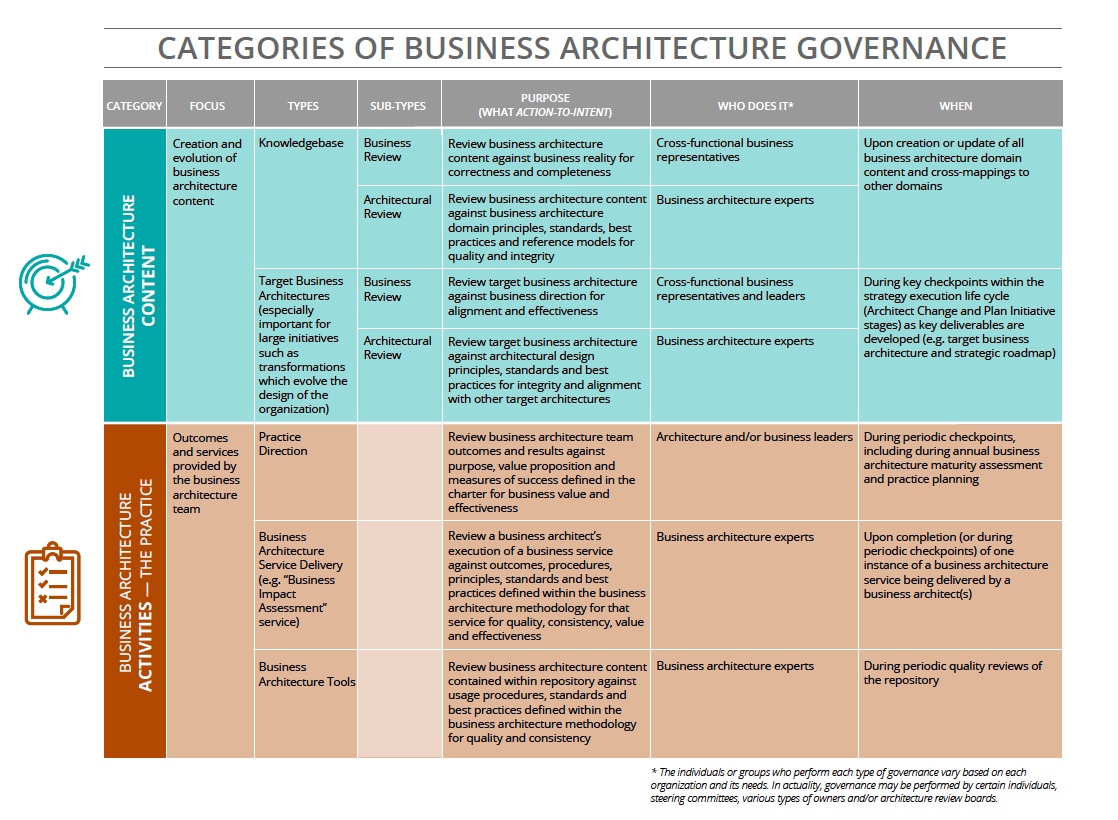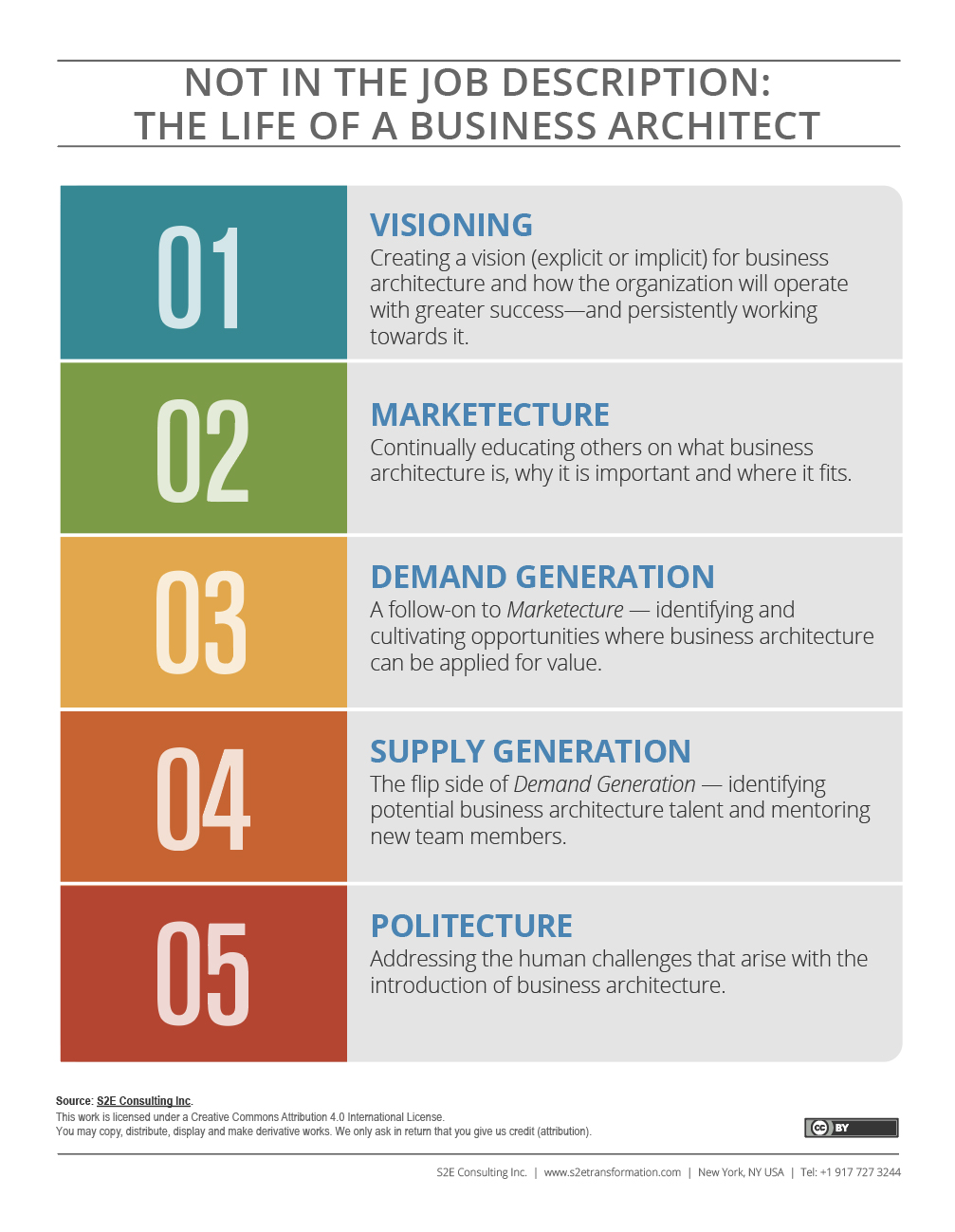 In this installment of StraightTalk, we are taking on a big, scary and loaded concept: business architecture governance. This topic is both filled with confusion and lack of information. (As noted by the sparse number of resources listed within More Good Stuff.) This is due in part to the relative newness of the business architecture discipline and the current maturity level of most organizations, as well as some of the history inherited from enterprise architecture governance.
In this installment of StraightTalk, we are taking on a big, scary and loaded concept: business architecture governance. This topic is both filled with confusion and lack of information. (As noted by the sparse number of resources listed within More Good Stuff.) This is due in part to the relative newness of the business architecture discipline and the current maturity level of most organizations, as well as some of the history inherited from enterprise architecture governance.
So, it’s time for some straight talk and we are going to cover this big topic in two bites. This post will give us a simple and practical explanation of what we should govern. Then, in our companion post, No. 39, we will look at how to implement it. Here goes.
What is business architecture governance?
There are many brainy definitions out there for architecture governance, and you can Google them to your heart’s content, but we will not provide any official ones here because they are not guaranteed to create clarity within this context.
There are almost no formal definitions for business architecture governance and the ones that do exist tend to be narrowly focused on just one aspect. For example, some references to business architecture governance focus on the Center of Excellence (CoE) and team structure, while others focus on a process for managing changes to business architecture.
So, let’s focus on some simple truths:
- There are multiple aspects of business architecture governance.
- Business architecture governance essentially compares action-to-intent.
- Business architecture governance is achieved with structures and processes to establish intent, monitor, and ensure accountability and outcomes.
- Business architecture governance exists to provide business value and outcomes — not bureaucracy.
What are all of the aspects of business architecture governance?
We can think about business architecture governance in two categories. First, we have Business Architecture Content, which focuses on the creation and evolution of business architecture content.*
*P.S. Remember that we create an enterprise-level business architecture baseline in our repository and then we leverage that when we want to make changes to the business, and those changes are reflected in target business architectures. If this is not ringing any bells, check out our Frequently Asked Business Architecture Questions, specifically FABAQ #5: “Shouldn’t we skip documenting current state and go right to a future state?” and its associated Additional Resources.
Second, we have Business Architecture Activities (a.k.a. the practice) which focuses on the outcomes and services provided by the business architecture team.
Within each of the two categories, we also have different types of governance, because we compare action-to-intent from a variety of perspectives. Here’s a quick overview:
- Business Architecture Content Governance
- Knowledgebase governance is performed by both cross-functional business representatives and business architecture experts to help us make sure the baseline business architecture content is correct, complete and high quality.
- Target business architecture governance is performed by both cross-functional business representatives and leaders as well as business architecture experts to help us make sure that target business architectures are designed with integrity and align with business direction and other target architectures. (This is especially important for large initiatives such as transformations which evolve the design of the organization.)
- Business Architecture Activities
- Practice direction governance is performed by architecture and/or business leaders to help us make sure that the business architecture team outcomes and results are delivering on the purpose, value proposition and measures of success defined in the charter.
- Business architecture service delivery governance is performed by business architecture experts to help us make sure that business architecture services (think business impact assessment service or a target state design service) are delivered with consistency and according to the outcomes, procedures, principles, standards and best practices defined within the team’s business architecture methodology.
- Business architecture tools governance is performed by business architecture experts to make sure that the business architecture content contained within the repository is high quality and consistent.
Make sure to check out the handy diagram below to help you put all of the pieces together.

BTW, the “Who Does It” on the diagram is intentionally generic since the who can vary by organization. Stay tuned, as we will explore more on steering committees, various types of owners and architecture review boards in our upcoming companion StraightTalk Post No. 39.
Can we have other types of business architecture governance other than those listed here?
Absolutely. Just make sure that a clear action-to-intent is being compared — and that the governance activities deliver business value.
Why do we need business architecture governance?
Historically, enterprise architecture governance has sometimes been perceived as an unnecessary layer of bureaucracy because the benefits to the business have been poorly communicated. This is an important lesson to take to heart when designing your own business architecture governance.
Considering that business architecture is becoming (or should be) a critical function of many organizations, governance is highly important to ensure the integrity of an organization’s business architecture — both the baseline and any evolution to it — as well as ensure that the business architecture practice is delivering on its intended outcomes and can scale to meet the needs of the organization.
What about other governance processes?
As with anything, we always need to remember that business architects work within an ecosystem of teams across the strategy execution life cycle. So for example, while there will be unique aspects of business architecture governance as described above, the overall enterprise architecture governance structures and processes should be considered and integrated with as well.
In addition, business architecture is an enabler for other governance processes, such as those which oversee the development of strategies and goals, the plans to achieve them, and the solutions which are delivered in support of them. (You can picture business architecture helping to compare action-to-intent at each stage of the strategy execution life cycle that we discussed in Post No. 3.)
Put it all together for me.
Okay, so if we were to create our own brainy-sounding definition of business architecture governance based upon all of this, a starting point might sound something like:
“The structures and processes to manage and control the integrity and effectiveness of all business architecture activities, and the creation and evolution of business architecture content.”
Business architecture governance is not an isolated, theoretical activity. It is about something much bigger: the organization itself. An organization’s business architecture represents the very design of the organization and target business architectures also reflect how the organization will change as a result of the strategic business direction. So, business architecture governance is actually a means of ensuring a solid design for an organization as well as its future evolution.
More Good Stuff…
Business Architecture Governance Content (BIZBOK® Guide): Check out Section 3.2 in the BIZBOK® Guide (Business Architecture Guild® membership required) for some information on business architecture governance. Note: This section actually focuses more on the business architecture team structure and roles, which is equivalent to what we’ve covered more extensively as business architecture practice-related topics in the following StraightTalk posts: No. 4, No. 5, No. 6, No. 7, No. 8, No. 33, No. 35, and No. 36.
The 7 Styles of Enterprise Architecture Governance (Simplicable by Anna Mar): An interesting take on seven common models of EA governance centered around who has decision making authority.
As Work Gets More Complex – 6 Rules to Simplify (TED Talk): An engaging TED Talk by Yves Morieux on how to manage the new complexity of business without getting complicated. His six rules not only guide us towards simplicity but also towards better ways to govern and manage quality.
Calling All StraightTalk Readers
We have received lots of ideas and suggestions for new posts. We love hearing from our readers and we’re open to your thoughts, questions or comments about business architecture. To that end, we have a new page on our site called “Let’s Talk.” Please visit the form to submit your topics related to business architecture. You may see your idea as a source for inspiration for an upcoming StraightTalk post!
Share Your Ideas >





